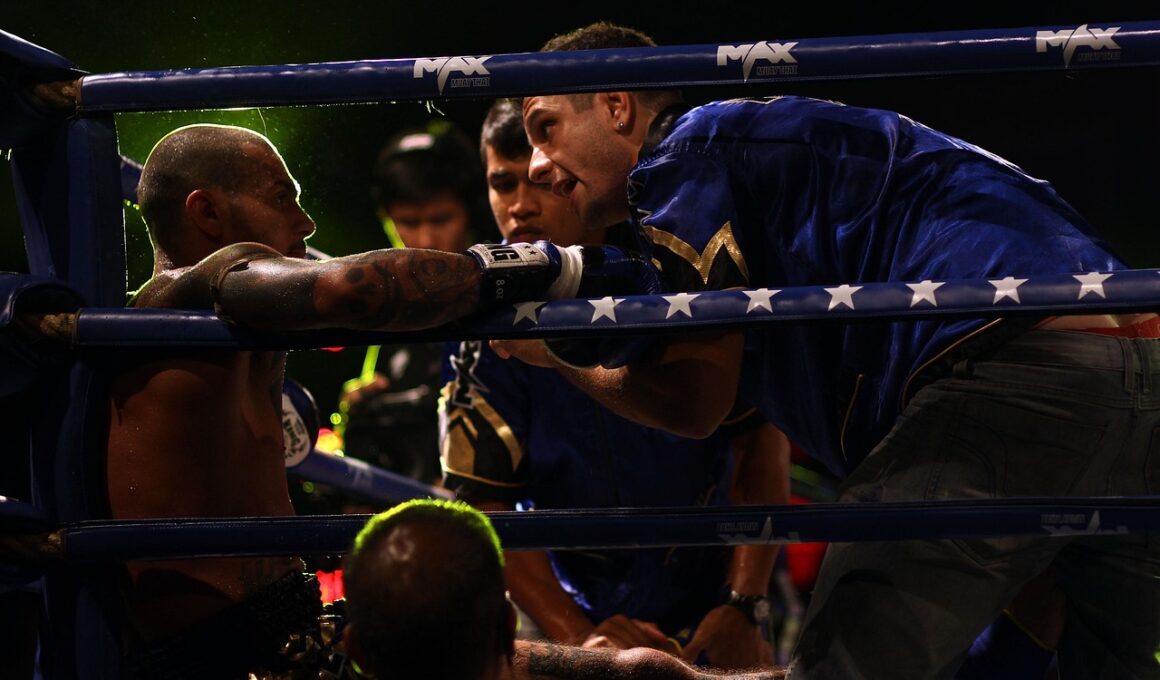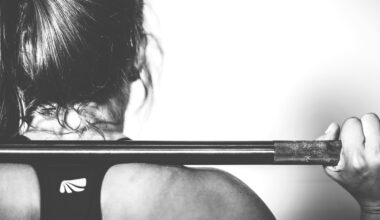The Science Behind Muay Thai Clinch Control
In the realm of martial arts, Muay Thai, also known as the “Art of Eight Limbs,” offers a unique focus on clinch control techniques. This discipline, originating from Thailand, integrates punches, kicks, elbows, and knee strikes, paired with advanced grappling strategies. Clinch control is crucial for a fighter’s success; it allows them to neutralize an opponent’s offense and create opportunities for effective strikes. Understanding the mechanics and principles behind effective clinch techniques provides practitioners with a comprehensive skill set in combat. In this article, we delve into the science that governs effective clinch control strategies. Key elements include body positioning, leverage, and timing. Effectively using body weight can shift the advantage in a clinch, allowing a fighter to exert pressure while minimizing their vulnerability. Furthermore, applying balance to maintain control enhances offensive and defensive capabilities during exchanges. Studying the biomechanical aspects of these techniques enables fighters to improve clinch performance. By examining components such as joint movements, muscle engagement, and footwork, practitioners can create a personalized approach to achieving clinch mastery, ultimately elevating their overall performance in Muay Thai.
Progressing in Muay Thai calls for a keen understanding of key concepts related to clinch control, such as dominant positioning. A fighter must always strive to gain superior position, which often allows them to unload strikes while minimizing counters. Key techniques include seat belt grips and underhooks, both vital for establishing dominance in the clinch. The seat belt grip, formed by wrapping one arm around the opponent’s waist, provides significant leverage. In contrast, underhooks allow a fighter to control the opponent’s arms, limiting their ability to strike back. During an exchange, these grips can shift quickly, so being able to transition between them efficiently is crucial. Training exercises focused on these grips not only enhance control but also improve the overall physical conditioning required to maintain a successful clinch. Moreover, timed drills that mimic real fighting scenarios can strengthen the fighter’s instinct, allowing for quick adaptations during sparring or competition. Practicing such drills with intention facilitates muscle memory, making it easier to apply techniques under pressure. Students can also incorporate resistance training when perfecting these grips and transitions, promoting strength and endurance essential for effective performance.
Biomechanics of Clinch Control
Understanding the biomechanics involved in clinch control is essential for Muay Thai practitioners aiming to improve their skills. The application of physics—primarily force, mass, and acceleration—plays a fundamental role in successful clinch techniques. By leveraging body weight against an opponent, a fighter can effectively manipulate their balance and positioning. For example, by shifting weight from the rear foot to the front foot, a fighter can apply leverage while simultaneously creating the angle needed for effective strikes. This dynamic movement reduces the opponent’s ability to counter effectively. Additionally, core strength development is paramount in stabilizing the body during clinch exchanges. Strong core muscles support better posture and facilitate movement throughout techniques. Moreover, practitioners must apply proper breathing techniques to maintain stamina over the duration of a match. Controlled breathing can help stabilize the body and manage fatigue resulting from intense exchanges. Visualization and mental practice of techniques enhance understanding of body mechanics, leading to more successful execution during sparring or bouts. Finally, understanding the limits of one’s physical capabilities will help fighters avoid injury while honing their skills effectively in the crucial clinch position.
A major component to consider in clinching is the effectiveness of various striking techniques followed by quick transitions. When a fighter successfully lands a knee strike, for instance, they should aim to maintain their grip and position for the next technique. This ability to seamlessly alternate between strikes during clinch exchanges can overwhelm an opponent. Emphasizing the importance of adaptability in clinch situations can lead to unexpected outcomes in a match. It is vital to remain aware of the opponent’s movements, as they may attempt to escape or counter. Reacting swiftly to these changes requires consistent practice and situational drills, reinforcing the concept of real-time adaptability. Engaging in controlled sparring rounds can yield insights into timing and execution, ultimately improving responses to various scenarios. Additionally, utilizing a partner to practice clinch strategies while maintaining a dynamic approach can reveal effective counters to common escapes. This partner training encourages a deeper understanding of the nuances in clinching while developing both offensive and defensive strategies. With sustained effort and focus, practitioners can transform their clinch control from basic to advanced levels, demonstrating the power of effective striking combined with sound tactical preparation.
Common Mistakes in Clinch Techniques
A variety of common mistakes exist within clinch techniques that can hinder a fighter’s performance in Muay Thai. Understanding and avoiding these errors will improve the efficiency of clinch maneuvers and overall success in matches. One prevalent mistake is failing to secure grips effectively, often leading to being thrown off balance. Ensure that grips are maintained tight to prevent opponents from slipping away. Additionally, overcommitting to strikes can leave a fighter vulnerable. Striking from a clinch requires an understanding of range and impact power. Fighters may also neglect their footwork, which is key in maintaining balance and creating angles. Poor footwork can hinder positioning to strike effectively or set up counterattacks. On the other hand, excessive reliance on brute strength can lead to fatigue and poorly executed techniques. Lastly, fighters should avoid forcing the clinch; instead, use strategic timing to initiate engagements. Practicing drills that reinforce correct techniques during sparring will enhance overall performance and minimize errors. Training with skilled partners will additionally highlight these common pitfalls, enabling fighters to rectify mistakes and refine their clinch strategies in real-time scenarios.
The mental aspect of clinch control is equally important as physical techniques in Muay Thai. Remaining relaxed yet focused in high-pressure situations ensures better decision-making. A fighter should practice mindfulness and stay attuned to their emotions, cultivating patience during entanglements. Developing a strong mental game can help a fighter respond to tricky situations, particularly when opponents may engage in deceptive maneuvers. Visualization techniques can enhance mental preparedness, allowing practitioners to envision themselves executing ideal clinch techniques seamlessly. Additionally, analyzing past performances and learning from mistakes can significantly boost a fighter’s confidence and proficiency. Setting specific goals for improvement in clinch control will target areas that require attention, ensuring steady growth in skill level. Furthermore, incorporating breathing exercises into training can help regulate stress responses. Increased focus on the exchanges during roster engages can aid practitioners in maintaining composure against an opponent’s aggression. Adopting a mindset geared toward continuous learning fosters resilience, allowing individuals to confront challenges proactively. Mental strategies applied alongside technical prowess lead to an unstoppable combination, significantly enhancing performance in the demanding world of Muay Thai competition.
Conclusion and Future Directions
In conclusion, mastery of Muay Thai clinch control is integral for any fighter looking to excel in the sport. The insights gained from understanding biomechanics and common pitfalls can aid practitioners in their ongoing development. Improving clinch techniques through focused training will enhance a fighter’s overall skill set. Additionally, emphasizing adaptability and mental preparedness will result in more agile fighters capable of outmaneuvering opponents. Future directions in clinch training could include the integration of technology, such as video analysis to track improvements. Coaches may utilize insights from biomechanical studies to refine training techniques. Implementing innovative strength and conditioning exercises specific to clinch techniques can elevate performance further. Moreover, fostering a collaborative training environment that encourages feedback among peers can introduce fresh perspectives on mastering the clinch. Continuous adaptation to training methods ensures that fighters remain at the forefront of evolving techniques within the sport. As practitioners embrace these developments, they will unlock their full potential in the captivating world of Muay Thai. The journey toward clinch mastery requires dedication, but the rewards of improved performance and competitive success are well worth the effort.


